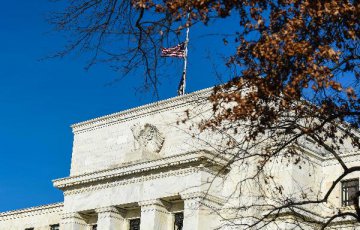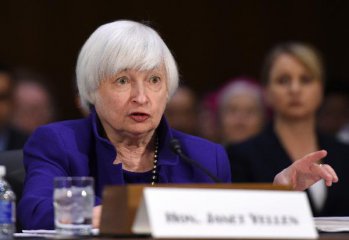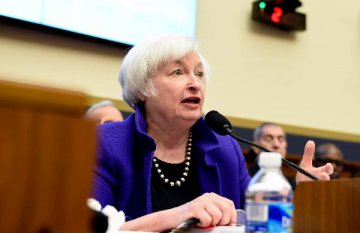WASHINGTON, Sept. 18 (Xinhua) -- U.S. Federal Reserve on Wednesday lowered interest rates for the second time this year amid growing risks and uncertainties stemming from trade tensions and a global economic slowdown.
The Federal Open Market Committee (FOMC), the Fed's rate-setting body, trimmed the target for the federal funds rate by 25 basis points to a range of 1.75 percent to 2 percent after concluding its two-day policy meeting, following a rate cut in late July that was its first in more than a decade.
TRADE POLICY UNCERTAINTY
Despite strong labor market and robust growth in household spending, "business fixed investment and exports have weakened," the FOMC said in a statement.
"On a 12-month basis, overall inflation and inflation for items other than food and energy are running below 2 percent," the central bank's inflation objective, it said.
"The main reasons appear to be slower growth abroad and trade policy developments -- two sources of uncertainty that we have been monitoring all year," Fed Chairman Jerome Powell told reporters at a press conference Wednesday afternoon.
"Trade policy tensions have waxed and waned, and elevated uncertainty is weighing on U.S. investment and exports," said the U.S. central bank chief, who also noted that monetary policy can counteract weakness to some extent, but "there's a piece of this that we really can't address."
"We need to look through what's a pretty volatile situation," said Powell. "That means, not overreacting quickly, it means not underreacting too. That's what we're trying to do."
Bill Dudley, former president of the Federal Reserve Bank of New York, said earlier this month that the central bank needs to be "cautious" that it does not "inadvertently enable the president's trade war with China."
U.S. President Donald Trump again lashed out at the central bank shortly after the rate cut announcement, saying in a tweet that "Jay (Jerome) Powell and the Federal Reserve Fail Again. No 'guts,' no sense, no vision! A terrible communicator!" The president has repeatedly demanded a larger cut.
In response to a question regarding Trump's comment, Powell reaffirmed the central bank's independence. "I assure you that my colleagues and I will continue to conduct monetary policy without regard to political considerations. We're going to use our best judgment based on facts, evidence and objective analysis in pursuing our goals," he said.
GROWING DIVIDE WITHIN FED
Three of the 10 members of the committee voted against the quarter-point rate cut decision, highlighting growing split among monetary policymakers. "The last time we saw three dissenting votes occurred in September 2016," said Diane Swonk, chief economist at Grant Thornton, a major accounting firm.
As in July, Federal Reserve Bank of Boston President Eric Rosengren, and Kansas City Fed President Esther George "preferred" to maintain the target range for the federal funds rate at the previous level. St. Louis Federal Reserve President James Bullard, meanwhile, demanded a larger cut, by 50 basis points.
When asked about how he viewed the divided opinions, Powell said at the press conference that this is difficult judgement, and such divisions are "nothing but healthy."
Five FOMC participants at the meeting this month don't support two rate cuts this year, according to the latest FOMC participants' assessments of appropriate monetary policy, which was also released on Wednesday. Not all participants have voting rights.
Seven out of the 17 Fed officials expect one more rate cut this year, and the central bank's median forecasts for rates suggested no more cut this year, as the "dot plot" showed.
"Our eyes are open, we're watching the situation," Powell said, without specifying the Fed's next move. "I'd love to be able to articulate a simple, straightforward, stopping rule, but it'll be when we think we've done enough."
Swonk wrote in an article Wednesday that her team's forecast now includes one more rate cut in December, "contingent upon shifts in trade policy."
"The next rate cut will also be contingent upon trade tensions and whether additional tariffs on China and Europe are imposed. If tariffs are rolled back, the Fed would likely remain on the sidelines in December," she said.
NEGATIVE RATES NOT AN OPTION
When asked about what tools the Fed would consider using if economic conditions worsen, Powell said the U.S. central bank would not use negative rates as a tool to stimulate the economy in the future, citing similar decisions during the 2008 financial crisis.
"Negative interest rates is something that we looked at during the financial crisis and chose not to do," Powell said at the press conference.
"After we got to the effective lower bound, we chose to do a lot of aggressive forward guidance and also large scale asset purchases and those were the two unconventional monetary policy tools we used extensively," Powell said, noting that such tools worked "fairly well."
"I don't think we'd be looking at using negative rates. I just don't think those will be top of our list," said the U.S. central bank chief.
"This should alleviate some concerns in the banking industry that negative rates might be on the horizon. It does not mean, however, the Fed has ruled out negative rates," Swonk said.
Powell's remarks, however, contrasted with some other central bankers such as the European Central Bank (ECB) President Mario Draghi, who had described the ECB's recent easing measures, including negative rates, as "powerful" not only in the short term but also in the long run.
Commenting on the recent inverted yield curve, which was widely reviewed as an indicator for a looming recession, Powell said the Fed monitors the yield curve carefully, along with a large wide range of financial conditions.
"From my perspective, you watch it carefully and I think you need to be asking yourself a lot of questions. If the yield curve isn't good, why that is and how long that's sustained," he said.
The overnight rate on Treasury repurchase agreements soared earlier this week amid a shortage of dollars, prompting the Federal Reserve Bank of New York to inject billions of dollars in cash into the markets to bring down short-term borrowing costs that threatened to push up its target range for the benchmark interest rate.
"If we experience another episode of pressures in money markets, we have the tools to address those pressures," Powell said, suggesting that the central bank might resume the organic growth of its balance sheet in the near future.






















Latest comments